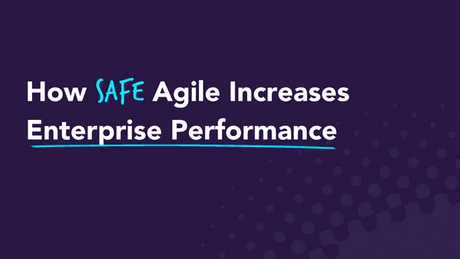Agile best practice
7 min read

5 Things to Avoid During an Enterprise Agile Transformation
Tue Oct 12 2021
Business agility is quickly becoming a valued asset in every industry. Whether you're in software development — the industry that popularized the agile methodology — or leading a consumer-facing business, agility can make your team more valuable, productive, and adaptable.
However, agile was intended for small, start-up teams. How can you apply this methodology to an enterprise?
This is where enterprise agile comes in. However, it takes time to transition to agile. Plus, enterprise agile transformation isn't always easy. If you're not careful, you might run into roadblocks along the way. 🚧
If you want to turn your enterprise into an agile organization, watch out for these potential issues during your transition and use our tips to avoid them.
Agile made easy for everyone on your team
Easy Agile apps for Atlassian's Jira
1. Not upskilling your team
Throwing your team members straight into an enterprise agile environment can leave them flopping like fish out of water. In a traditional enterprise, employees are often siloed into individual teams that primarily work alone. But the Agile Manifesto emphasizes the need for business people and product development teams to collaborate.
A big reason why leaders fail to implement the agile approach in large organizations is because workers aren't prepared for this transition. When you go agile, workers may need new skills. Team members may need to learn how their specialized skill sets fit into new business processes.
Some team members may even get new roles. For instance, your organization may designate a Scrum Master role to existing employees. Your Scrum Masters must facilitate sprint planning and other processes that your existing team members may be unfamiliar with.
Bottom line: Your team members aren't superhuman. They need guidance to transform with your organization. Your enterprise agile transformation leaders must be clear about each person's role and their value in your changing work environment. If needed, give your team members access to learning or coaching opportunities, so they can better fit into their roles.
You can also help your team members by providing agile training, getting feedback, making webinars and white papers that define new processes or terms, and simply being available for support.
2. Limiting enterprise agile implementation to pilots

Agile transformation doesn't happen all at once. At the enterprise level, agile practices are usually implemented on a few teams first. This allows leaders to see the potential impact of enterprise agility, spot any room for improvement, and create a plan for scaling up.
The issue is, all too many enterprises don't follow through with large-scale agile adoption. Some leaders fail to prioritize agile for their organizations, while others are too skeptical or scared to proceed.
Stopping at the pilot phase will lead you right back to where you started — with some wasted time — at best. At worst, you can be left with a disjointed organization, one that includes a blend of agile teams and non-agile teams.
To prevent your enterprise agile transformation from stopping in its tracks, you first need to get buy-in from leaders and key stakeholders. When everyone knows the value of going agile, backing out becomes a less likely scenario.
It's also helpful to develop a rolling 90-day plan for your implementation. While your plans might change during your agile roll-out — continuous improvement is key — proactively thinking about what needs to happen over the next quarter can keep you on track. Plus, you'll remain committed to scaling up your enterprise agility. 📈
3. Not leading with a clear vision
High-quality enterprise agile transformation starts with a strong leadership team. When your leaders don't have a shared vision of the agile rollout — from its goals to what it will look like — it's unlikely the rest of your organization will be aligned. Some of your teams may interpret agile principles differently than others. (How many ways can you describe "Kanban" anyway?)
Without a clear vision of what you want to achieve, your team members may resist change, too. If your team members don't know where they're headed, it'll feel like hopping in a stranger's car or blindly hopping on a plane. ✈️ Even if they have enormous trust in you as their leader, they won't be as ready and willing to follow.
If you work with your leadership team to establish a vision before you start your broader transformation, you can better succeed in your organizational change management. Not only will you be more organized as you start to shift processes and teams, but you'll likely also have employees who are excited to go through the change with you.
🔔 Ensure team alignment & transparency with Easy Agile Roadmaps for Jira
4. Not measuring your agile transformation success

Whenever you're implementing new ways of working, your business results can change — for better or for worse. When you don't measure your results, it's hard to keep track of which direction you're headed. You may end up making highly subjective decisions or assumptions.
As you're going through your enterprise agile transformation, keep an eye on key metrics to understand how agile methods really affect your business outcomes. For instance, you can track your planned-to-done ratio, which is the percentage of projects in your backlog that your team completes in a set time frame. The higher this number is, the more productive your team is, which means the agile methodology is working as you intended.
If you're not keeping track of your agile metrics — ideally, at least once every 30 days — you may struggle to see what you need to improve or shift in the transformation process. On the flip side, knowing the numbers behind your business can help you get proactive in improving your agile processes.
5. Not building an agile culture
An enterprise agile transformation isn't just a shift in how your organization works. It can also require a total shift in how your team members think, act, and work together. For example, whereas a traditional business may focus on their goals when making decisions, enterprise agile frameworks require your team members to put clients at the center. Team members also need to learn how to work closely together, whether or not they're in the same department.
Much like a lack of vision, a lack of an agile culture can lead your team members — and even your leadership — to resist change. Your employees won't shift to an agile mindset if you're still taking a top-down approach, in which only leaders are included in conversations and red tape hinders good communication.
Large-scale agile adoption requires your entire team to celebrate a culture that aligns with agile principles. When your culture supports agile development, the whole of your organization can shift toward your desired ways of working.
Put a scaled agile framework into practice
Large enterprises have much more to consider when going agile than a startup or small team. For instance, you need to start with agile pilots, but avoid limiting yourself to them, and offer agile training to a much larger group of professionals. With our tips — and the right tools — you can help your team go agile with greater ease.
Easy Agile Programs for Jira is one tool that you can use to support your enterprise agile efforts. You can use this tool to run smoother PI planning sessions that help all your team members visualize and align on the same objectives. For large-scale organizations, Easy Agile Programs is an ideal tool for embracing cross-functional teams and fostering a strong agile culture.


